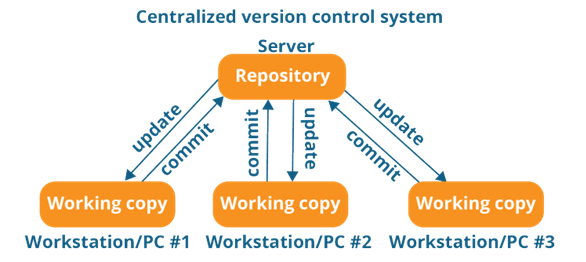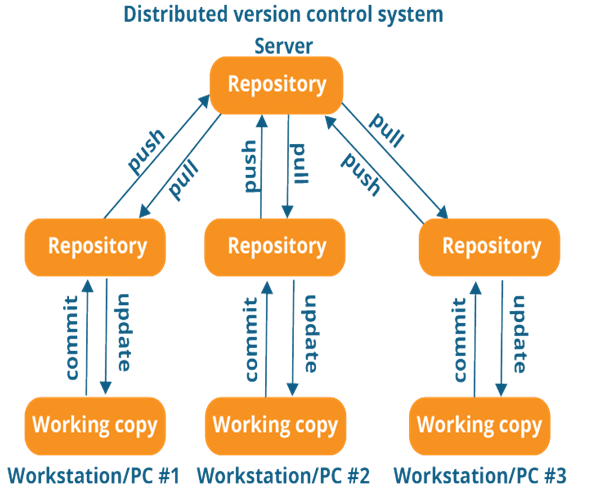
DevOps is a software development and conveyance process that indicates correspondence and joint effort between product management, programming advancement, and operations professionals.It underpins this via computerizing and checking the procedure of programming incorporation, testing, organization, and framework changes by setting up a culture and condition where building, testing, and discharging programming can happen quickly, much of the time, and all the more dependably. Get in touch with OnlineITGuru for mastering the Devops online training
Before going to know about Git let’s have a brief understanding of Version Control Systems
Version Control System (VCS) is software that cooperates and keeps up an entire history of their work.
Below are the functions of a VCS:
- Enables engineers to work all the while.
- Does not permit overwriting each other's changes
- Maintains a history of every version.
Centralized VCS
Centralised version control systems (CVCS) utilize a central server to store all records and empower group joint effort. Especially It deals with a solitary store to which clients can directly communicate with to a central server.
The repository in the above chart demonstrates a central server that could be local or remote which is directly associated with each of the software engineer's workstation. Each developer can concentrate or refresh their workstations with the data present in the storehouse or can roll out improvements to the information or submit in the archive. Each operation performed specifically on the store. Despite the fact that it appears to be quite advantageous to keep up a solitary vault, it has some significant downsides. Some of them are:
- It is not locally accessible; which means you generally should be associated with a system to play out any activity.
- Since everything is concentrated, regardless of the central server getting smashed or corrupted will bring about losing the whole data of the project.
This is when Distributed VCS helps.
Distributed VCS
These systems don't really depend on a central server to store every one of the renditions of a project file.
In Distributed VCS, every contributor has a local copy or "clone" of the fundamental store i.e. everybody keeps up their very own local storehouse which contains every one of the records and metadata present in main repository.
You will comprehend it better by referring to the diagram below:
As it is obvious in the above diagram, each developer keeps up a neighbourhood store alone, which is really the duplicate or clone of the central storehouse on their hard drive. They can submit and refresh their local archive with no impedance.
They can refresh their local storehouses with new data from the central server by an operation called "pull" and influence changes to the primary repository by an operation called "push" from their local repository.
Git:
Generally Git is a version control framework for tracking changes in computer files and organizing chip away at those documents among various individuals. It principally utilized for source code management in software development. However it can be utilized to monitor changes in any arrangement of records. As a dispersed update control system it is gone for speed, information integrity and bolster for distributed, non-linear workflows.
||{"title":"Master in DevOps ","subTitle":"DevOps Training by ITGURU's","btnTitle":"View Details","url":"https://onlineitguru.com/devops-course","boxType":"reg"}||
Git made by Linus Torvalds in 2005 for development of the Linux kernel, with other kernel developer’s adding to its underlying development. Its present maintainer since 2005 is Junio Hamano. Git is a dispersed alteration control and source code management system with an accentuation on speed. Git at first composed and created by Linus Torvalds for Linux bit improvement. In the same fashion Git is free software distributed under the terms of the GNU General Public License rendition 2
Git Life cycle :General work process is as per the following:
You clone the Git store as a working duplicate.
You alter the working duplicate by including/altering records.
In the event that vital, you additionally refresh the working duplicate by taking other developer changes.
You survey the changes before submit.
You submit changes. In the case of all is well, at that point you push the progressions to the storehouse.
Advantages of Git:
- Free and open source
- security
- Fast and small
- no need of powerful hard ware
- Implicit backup
- Easier branching
Recommended audience:
- Software Developer
- System Admins
- Who has exposure to automation
Prerequisites: DevOps, get started by understanding its principles and tools you need to learn to implement them. It’s a bit easy for CS background people to pick up when compared to other branches. But anyone can master it with proper learning and training. Get in touch with OnlineITGuru for mastering the Devops Online course

